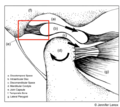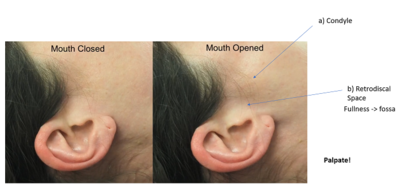◒
TMJ Examination
From WikiMSK
This article is still missing information.
Anatomy
Inspection
- Oral exam
- Head/chin deviations
- C curve occurs due to hypomobility, the mandible deviates to the involved side, then returns to centre
- S curve occurs due to hypermobility as a result of poor neuromuscular control.
Palpation
- Retrodiscal space. Line your finger tips up of fingers 2 through 5. Palpate the right and left TMJ with the posterior finger at the tragus. Allow a slight inferior angle of finger alignment.
- Coronoid Process: Begin with mouth closed, palpate inferior to the zygomatic bone. Ask the patient to open their mouth. If the coronoid process does not move forward to touch your finger then ask them to open further or adjust your finger location. Check all easily accessible coronoid aspects. Verbal cues are generally required for maintaining an open mouth. Palpation of the medial aspect can be accomplished intraorally if required.
- Masseter
Movement
- Range of motion. normal jaw opening is ~4-7cm, with a wide range of normal[1].
Videos
MCQs
References
- ↑ Zawawi KH, Al-Badawi EA, Lobo SL, Melis M, Mehta NR. An index for the measurement of normal maximum mouth opening. J Can Dent Assoc. 2003;69(11):737-741





